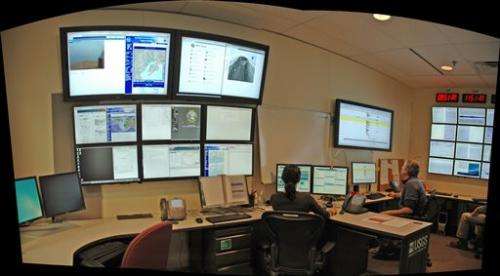US budget cuts pare real-time volcano monitoring (Update)

Scientists monitoring Alaska's volcanoes have shut down stations that track eruptions in real time and put off repairing seismic equipment due to U.S. budget cuts—moves that could delay getting vital information to pilots and emergency planners.
The Alaska Volcano Observatory can no longer seismically monitor five volcanoes with real-time equipment to detect imminent eruptions. Such equipment is especially important in helping pilots receive up-to-the-minute warnings about spewing ash, which can cause engine failures and other problems.
Alaska has 52 active volcanoes, with many of them on the Aleutians Islands along international airline routes between Europe, North America and Asia.
Alaska Airlines officials said the observatory, funded by the U.S. Geological Survey, provides a crucial service, including early warnings of seismic changes that may portend an impending eruption. Monitors need to be operating all the time, not just during major eruptions, said Betty Bollert, an Alaska Airlines dispatcher.
"I think the public gets kind of complacent when nothing exciting is happening ... and think, 'Oh, why should we throw money at that?'" said Bollert, who was on duty in 1989 when the Redoubt Volcano erupted 115 miles (185 kilometers) from Anchorage.
Following that eruption, several aircraft experienced damage from ash—including a Boeing 747-400 carrying 231 passengers that lost all four engines after flying into an ash cloud. The plane dropped more than two miles in five minutes before the crew was able to restart the engines and land safely in Anchorage.
Across the world, scores of flights are diverted each year because of volcanic activity. In 2010, an eruption in Iceland spread debris over Northern Europe, delaying air travel for millions of people as it threatened flight routes from the East Coast to Europe, and from Europe to Asia, the Middle East and Africa.
The Alaska volcano monitoring system, first created in 1988, aims to help pilots avoid such problems. But it has regressed over the past few years because of shrinking finances, and now the across-the-board U.S. spending cuts are further squeezing operations.
For example, gone is a plan to install seismic monitors at Cleveland Volcano, a remote mountain in the Aleutian Islands. The volcano experienced a low-level eruption earlier this month that continues to discharge steam, gas and heat, although no ash clouds have been detected in the past week.
"Because our budget has been declining for so long, we have no hope of actually addressing the Cleveland eruption in the way that it really should be," said geophysicist John Power, the USGS scientist in charge at the Alaska Volcano Observatory.
A second Alaska volcano began heating up Monday. Pavlof Volcano, 625 miles (1,000 kilometers) from Anchorage, does have seismic instruments, which picked up tremors signaling a possible eruption. Satellite imagery also showed a lot of heat in the mountain.
In Alaska, 32 volcanoes once had 200 working seismic instruments. Now 80 of those instruments have fallen into disrepair and can't be fixed due to the USGS budget cuts. That means five of those volcanoes aren't monitored electronically at all, and the number could rise if more instruments go without maintenance.
Cuts also have reduced the number of days helicopter crews can fly to repair equipment in remote locations from 140 days in 2008 to 36 days now.
The observatory still uses satellite data, infrasound and reports from pilots and others to detect eruptions. But none of those offer real-time information. Sound waves picked up the Cleveland eruption but it took 40 minutes for the data to reach scientists in Anchorage, 940 miles (1,510 kilometers) northeast of the volcano.
Decreasing funds also have forced staff reductions. These days the observatory is operating on $4 million annually, roughly half of its heyday budget.
Four other observatories in the U.S.—in Wyoming, California, Washington and Hawaii—also have faced cuts, leading to a reduction in lab research, studies of eruption histories and lava survey flights. In Hawaii, lava flyovers of the Big Island's Kilauea volcano have been cut from once a week to once every two weeks.
While these types of cuts may not be immediately felt by the public—unlike the furloughs of air traffic controllers that caused flight delays nationwide—they are just as damaging, said Tom Murray, chief of the five USGS observatories.
"The challenges with what we do is that it doesn't happen all the time," he said. "But when it does happen, then the ramifications can be very large."
© 2013 The Associated Press. All rights reserved.



















